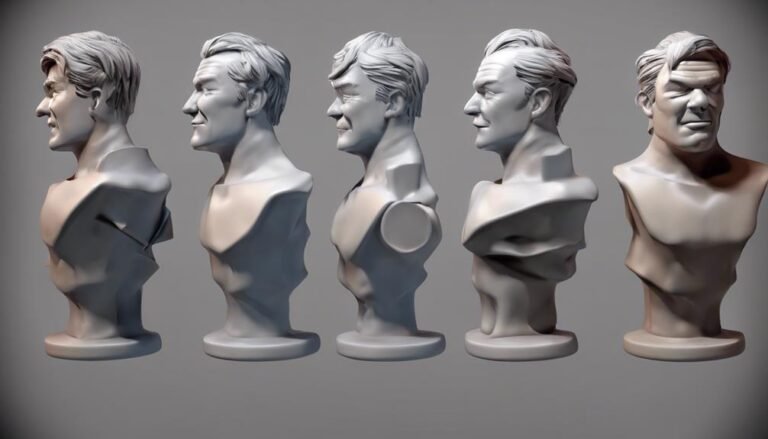Diagnostic Criteria for Personality Disorders
Did you know that up to 9.1% of the general population may be affected by a personality disorder at some point in their lives? Understanding the diagnostic criteria for these disorders can be complex, but by examining specific patterns of behavior and traits, clinicians can identify individuals who may benefit from targeted interventions. By exploring the distinct criteria for each personality disorder cluster and considering factors like interpersonal functioning and coping mechanisms, one can gain a deeper insight into the nuanced world of personality pathology.
Key Takeaways
- Criteria include pervasive patterns of behavior affecting multiple areas of life.
- Symptoms are inflexible and enduring, leading to distress or impairment.
- Traits manifest across various situations, starting in adolescence or early adulthood.
- Diagnosis requires careful assessment by mental health professionals.
- Different types (clusters A, B, C) have distinct characteristics and behaviors.
Cluster A Personality Disorders
Cluster A personality disorders, characterized by odd or eccentric behavior, include paranoid, schizoid, and schizotypal personality disorders. Paranoid traits are often seen in individuals with paranoid personality disorder, where there's a pervasive distrust and suspicion of others. These individuals may interpret benign actions of others as malicious and harbor grudges without reason.
On the other hand, schizoid traits, commonly found in schizoid personality disorder, involve a pattern of detachment from social relationships and a limited range of emotional expression.
Moving on to schizotypal features, individuals with schizotypal personality disorder exhibit odd behaviors and peculiar thoughts. They may have beliefs in magical thinking, experience perceptual distortions, and display eccentricities in speech and appearance. These odd behaviors set them apart from societal norms and can lead to difficulties in forming and maintaining relationships.
Recognizing these traits and behaviors is crucial in the diagnosis and management of Cluster A personality disorders.
Cluster B Personality Disorders
You're about to explore the traits exhibited by individuals with Cluster B Personality Disorders and the various treatment options available for managing these conditions.
Understanding the characteristics of Cluster B disorders, such as dramatic, erratic, and emotional behaviors, can provide insights into the challenges faced by those affected.
Delving into the treatment strategies, including therapy and medication, offers a thorough view of how professionals work towards helping individuals with Cluster B Personality Disorders.
Traits of Cluster B
Individuals with Cluster B personality disorders exhibit a pattern of behavior characterized by dramatic, emotional, and erratic traits. These traits are commonly seen in individuals diagnosed with Borderline, Narcissistic, Histrionic, and Antisocial Personality Disorders.
One key characteristic of Cluster B personality disorders is emotional dysregulation, where individuals struggle to manage their emotions effectively, leading to intense mood swings and impulsive behaviors.
Moreover, individuals with Cluster B personality disorders often display manipulative tendencies, using charm, deceit, or aggression to achieve their desired outcomes. This manipulative behavior can strain relationships and lead to conflicts in both personal and professional settings.
Additionally, individuals with Cluster B personality disorders may have a heightened sensitivity to perceived criticism or rejection, which can trigger intense emotional reactions and maladaptive coping mechanisms.
Understanding these traits is essential for early identification and intervention in individuals with Cluster B personality disorders. By recognizing the manipulative tendencies and emotional dysregulation commonly associated with these disorders, mental health professionals can provide tailored treatment approaches to help individuals manage their symptoms and improve their quality of life.
Treatment Options
Effective treatment options for personality disorders within Cluster B typically involve a combination of psychotherapy and medication management. Psychotherapy, such as cognitive-behavioral therapy (CBT) or dialectical behavior therapy (DBT), can help individuals with Cluster B personality disorders develop coping mechanisms, improve interpersonal skills, and manage emotional dysregulation.
Medication management is often used in conjunction with therapy to address specific symptoms like impulsivity or mood instability.
Holistic approaches, including mindfulness practices, yoga, and meditation, can also be beneficial in treating Cluster B personality disorders by promoting self-awareness and emotional regulation. Support groups provide individuals with Cluster B personality disorders the opportunity to connect with others who understand their struggles, offering a sense of community and validation.
Additionally, family therapy may be recommended to address relational dynamics and improve communication within the family unit. Collaborating with a multidisciplinary team that includes therapists, psychiatrists, and other mental health professionals can provide thorough care for individuals with Cluster B personality disorders.
Cluster C Personality Disorders
Cluster C Personality Disorders encompass traits such as avoidant behaviors and dependent patterns. These individuals often exhibit extreme shyness, fear of rejection, and a strong desire for reassurance.
Understanding the diagnostic criteria for these disorders can aid in recognizing and providing appropriate support for individuals experiencing these challenges.
Avoidant Personality Traits
Manifesting as a persistent sense of inadequacy and hypersensitivity to criticism, avoidant personality traits are characterized by a deep-seated fear of rejection and social interactions. Individuals with these traits often experience intense social anxiety, leading to avoidance of situations where they might be scrutinized or judged negatively. This fear can be so overwhelming that even the thought of engaging in social interactions can provoke significant distress.
Fearful avoidance is a key feature of avoidant personality traits, with individuals actively steering clear of activities that involve interpersonal contact for fear of being ridiculed or rejected. This avoidance can severely impact various aspects of their lives, from forming relationships to pursuing career opportunities. The constant worry about being embarrassed or humiliated can lead to isolation and loneliness, further exacerbating their sense of inadequacy.
It is essential to recognize these avoidant traits early on to provide appropriate support and interventions tailored to help individuals navigate and manage their social anxiety effectively. By addressing these fears and working on building self-confidence, individuals with avoidant personality traits can gradually learn to engage more comfortably in social interactions and overcome the limitations imposed by their condition.
Dependent Behavior Patterns
Individuals exhibiting dependent behavior patterns within Cluster C Personality Disorders often display an excessive need for others to take care of them and make decisions on their behalf. This behavior can lead to codependent relationships where individuals rely heavily on others for emotional and physical support, often neglecting their own needs in the process. Enabling behaviors from those around them can further perpetuate this cycle of dependency.
To address dependent behavior patterns, interventions such as assertiveness training can be beneficial. By learning to assert oneself and communicate needs effectively, individuals can gradually reduce their reliance on others and develop a sense of autonomy.
Additionally, practicing self-care practices is essential in fostering independence and self-sufficiency. Encouraging individuals to prioritize their own well-being and cultivate healthy coping mechanisms can help break the pattern of dependency.
Antisocial Personality Disorder Criteria
To meet the diagnostic criteria for Antisocial Personality Disorder, you must exhibit a pervasive pattern of disregard for and violation of the rights of others since the age of 15, as outlined in the DSM-5. This disorder is characterized by various traits, including engaging in criminal behavior and a notable lack of empathy towards others. Individuals with Antisocial Personality Disorder often display a consistent pattern of deceitfulness, impulsivity, irritability, aggressiveness, and reckless disregard for their own safety and the safety of others.
Criminal behavior is a key feature of this disorder, with individuals frequently engaging in unlawful activities such as theft, fraud, or physical violence. They may also show a lack of remorse for their actions and rationalize their behavior without consideration for the feelings or well-being of those affected.
Furthermore, a marked lack of empathy is evident in their interactions, as they tend to exploit and manipulate others for personal gain without regard for the consequences. To sum up, the diagnostic criteria for Antisocial Personality Disorder encompass a range of behaviors that reflect a fundamental disregard for societal norms and the rights of others.
Borderline Personality Disorder Criteria
The diagnostic criteria for Borderline Personality Disorder entail a pattern of instability in interpersonal relationships, self-image, and emotions, as defined in the DSM-5.
Individuals with Borderline Personality Disorder often exhibit emotional dysregulation, struggling to manage their feelings effectively. This emotional instability can lead to impulsive behaviors, such as reckless spending, substance abuse, or risky sexual behavior.
Moreover, self-harm is a common characteristic of Borderline Personality Disorder, with individuals engaging in cutting, burning, or other self-injurious behaviors as a way to cope with intense emotional distress.
The intense relationships experienced by those with Borderline Personality Disorder may involve idealizing someone one moment and then quickly shifting to devaluing them in response to perceived slights or abandonment fears.
These individuals may also experience chronic feelings of emptiness and exhibit sudden mood swings.
The presence of at least five of nine specific criteria outlined in the DSM-5 is necessary for the diagnosis of Borderline Personality Disorder. Proper assessment and treatment by mental health professionals are essential in helping individuals manage these challenging symptoms.
Narcissistic Personality Disorder Criteria
The diagnostic criteria for Narcissistic Personality Disorder, as outlined in the DSM-5, focus on a pervasive pattern of grandiosity, a need for admiration, and a lack of empathy. Individuals with this disorder often exhibit an inflated sense of self-importance, a constant craving for attention and validation, and a tendency to disregard the feelings and needs of others.
When considering treatment approaches for Narcissistic Personality Disorder, therapy, such as cognitive-behavioral therapy, can be beneficial in addressing maladaptive behaviors and thought patterns. Coping strategies may include building self-awareness, practicing empathy, and developing healthier ways of seeking affirmation.
Identifying triggers that exacerbate narcissistic behaviors is crucial in managing this disorder. By recognizing situations or emotions that lead to grandiose or entitled responses, individuals can work towards regulating their reactions.
Setting boundaries with others can also aid in establishing healthier interpersonal relationships and reducing conflicts related to narcissistic tendencies. Therapy can provide a safe space to explore these triggers and boundaries, fostering personal growth and improved self-awareness.
Conclusion
So, you've successfully navigated through the intricate world of personality disorder diagnostic criteria. Congratulations! Now you can expertly identify those odd, dramatic, or avoidant behaviors in yourself and others.
Remember, it's all just a label – who needs normalcy anyway? Keep analyzing those maladaptive coping strategies like a pro, and never forget, personality disorders are just a personality quirk on steroids.
Keep diagnosing, my friend.







